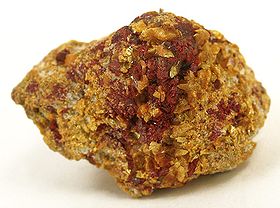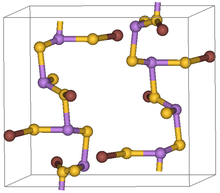- Lorandite
-
Lorandite
Catégorie II : sulfures et sulfosels[1]
Lorandite rouge sur orpiment, Allchar, Macédoine, 3.4 x 2.7 x 2.4 cm Général Classe de Strunz 2.HD.05 Formule brute TlAsS2 Identification Masse formulaire[2] 343,435 ± 0,01 uma
As 21,82 %, S 18,67 %, Tl 59,51 %,Couleur rouge cochenille, rouge carmin, gris de plomb, noirâtre, jaune ocre Classe cristalline et groupe d'espace prismatique; P 21/a Système cristallin monoclinique Réseau de Bravais primitif P Clivage excellent sur {100}, très bon sur {201}, bon sur {001} Cassure flexible Habitus prismatique, tabulaire, pyramidal, grenu Échelle de Mohs 2-2,5 Trait rouge, rouge cerise Éclat métallique, adamantin Propriétés optiques Indice de réfraction a=2.720 Pléochroïsme faible, y: rouge pourpre, z: orange-rouge Biréfringence biaxial(+); 2.720 Dispersion 2vz ~ large, r >> v Fluorescence ultraviolet aucune Transparence translucide à transparent Propriétés chimiques Densité 5.5288 - 5.5362 Propriétés physiques Magnétisme aucun Radioactivité aucune Unités du SI & CNTP, sauf indication contraire. La lorandite est une espèce minérale du groupe des sulfosels de formule TlAsS2.
Sommaire
Historique de la description et appellations
Inventeur et étymologie
La lorandite a été décrite en 1894 par József Krenner; elle fut nommée ainsi en l'honneur du Professeur Loránd Eötvös (1848-1919), physicien, mathématicien et politicien de Budapest.
Topotype
Caractéristiques physico-chimiques
Cristallochimie
La lorandite fait partie d'un groupe de minéraux aux compositions chimiques semblables: le groupe des sulfosels de l'archétype SnS (sulfure d'antimoine) et plus précisément du sous-groupe contenant les minéraux appartenant à ce groupe et possédant en plus l'élément thallium (Tl).
- Sous-groupe de la lorandite
- Lorandite: TlAsS2, P 21/a; 2/m
- Weissbergite TlSbS2, P1; 1
Cristallographie
- Paramètres de la maille conventionnelle: a = 12.28(1) Å, b = 11.30(1) Å, c = 6.101(6) Å, β = 104,6 °, Z = 8, V = 819,26 Å3
- Densité calculée = 5,51-5,53
Propriétés physiques
- Habitus
- La lorandite se trouve sous la forme de petits cristaux prismatiques ou tabulaires sur {201}, pyramidaux, présentant de nombreuses formes, striés parallèlement selon [001], ou encore aciculaires et en grains. Les cristaux peuvent atteindre 5 centimètres, ils sont flexibles, et leur clivage forme des lamelles et des fibres avec une déformation plastique.
Gîtes et gisements
Gîtologie et minéraux associés
- Gîtologie
- Bien que rare, la lorandite est le minerai de thallium le plus répandu. Elle a une origine hydrothermale et se forme généralement à des températures relativement basses.
- Minéraux associés
- stibine, réalgar, orpiment, cinabre, vrabite, greigite, marcassite, pyrite, tétraédrite, sphalérite, arsenic, barytine.
Gisements producteurs de spécimens remarquables
- Chine
- Zimudang Au-Hg-(Tl) deposit/Lanmuchang Tl-(Hg) deposit, Xian de Xingren, Préfecture autonome buyei et miao de Qianxinan, Guizhou[4],[5]
- Xiangquan Tl deposit, Xian de He, Préfecture de Chaohu, Anhui[6]
- États-Unis
- Rambler Mine, Red mountain, Encampment, District de Encampment, Comté de Carbon, Wyoming
- New Rambler Mine, New Rambler District, Comté d'Albany[7]
- Getchell Mine, Adam Peak, District de Potosi, Comté de Humboldt, Nevada[8]
- Enfield Mine (Jerritt Canyon gold mine; Bell mine; Marlboro Canyon; Allchem; Generator Hill pits), Independence Mountains District, Comté d'Elko, Nevada[9]
- Iran
- Mine Zareh Shuran, Takab, Azerbaïdjan occidental[10]
- Macédoine
- Allchar (Alsar), Roszdan[3]
- Suisse
- Carrière de Lengenbach, Im Feld, Binntal, Canton du Valais[11]
Croissance des minéraux
Des monocristaux de lorandite peuvent être cultivés à partir d'un mélange de nitrate de thallium (TlNO3), d'arsenic et de soufre élémentaires en solution aqueuse concentrée d'ammoniac. Le mélange est placé dans un autoclave et est maintenu à une température élevée (~ 250 °C) pendant plusieurs jours. Cette méthode donne des cristaux prismatiques allongés le long de [001] et rouges foncés[12].
Notes et références
- La classification des minéraux choisie est celle de Strunz.
- Masse molaire calculée d’après Atomic weights of the elements 2007 sur www.chem.qmul.ac.uk
- Math. és Term.tud.Ert.(1894) 12, 473
- Zhiwei Bao, Zhenhua Zhao, Guha, J., and Williams-Jones, A.E. (2004): Geochemical Journal 38, 363-381.
- Zhang Baogui, and Zhang Zhong (2001): The biological and reworking metallogenic models of the Lanmuchang Tl deposit. Paper at the 11th Annual V.M. Goldschmidt Conference.
- Zhou, T.F., Fan, Y., Yuan, F., Wu, M.A., Hou, M.J., Voicu, G., Hu, Q.H., Zhang, Q.M., and Yue, S.C. (2005): Mineralogy and Petrology 85(3/4), 243-251
- Dana 7:I:293,439.
- Mineral News: 19(12): 1, 3.
- Min.Rec.:20:469.
- Mehrabi, B., Yardley, B.W.D., and Cann, J.R. (1999): Mineralium Deposita 34, 673-696.; Asadi, H.H., Voncken, J.H.L, Kühnel, R.A., and Hale, M. (2000): Mineralium Deposita 35, 656-671.
- Graeser, S. (1967): Contributions to Mineralogy and Petrology 16(1), 45-50.
- http://en.wikipedia.org/wiki/Lorandite
- Krenner (1894), Mat. Termés. Ért.: 12: 473.
- Krenner (1895), Mat. Termés. Ért.: 13: 258.
- Krenner (1897), Zs. Kr.: 27: 98.
- Palache, C., H. Berman, and C. Frondel (1944) Dana’s system of mineralogy, (7th edition), v. I, 437–439.
- Berry, L.G. and R.M. Thompson (1962) X-ray powder data for the ore minerals. Geol. Soc. Amer. Mem. 85, 146–147.
- Vlasov, K.A., Ed. (1966) Mineralogy of rare elements, v. II, 592–597.
- Radtke, A.S., C.M. Taylor, R.C. Erd, and F.W. Dickson (1974) Occurrence of lorandite, TlAsS2, at the Carlin gold deposit, Nevada. Econ. Geol., 69, 121–174.
- Bali´c-ˇZuni´c, T., E. Makovicky, and Y. Mo¨elo (1995) Contributions to the crystal chemistry of thallium sulfosalts III. The crystal structure of lorandite (TlAsS2) and its relation to weissbergite (TlSbS2). Neues Jahrb. Mineral., Abh., 168, 213–235.
- Z. Kristall.: 30: 272-294.
- Contributions to Mineralogy and Petrology: 16: 45-50.
- Acta Crystallographica: 12: 1002-1006.
- Portail des minéraux et roches
- Portail de la chimie
Catégories :- Arsenic (minéral)
- Thallium (minéral)
- Sulfosel
Wikimedia Foundation. 2010.



